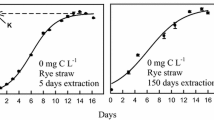Abstract
The presence of rotting barley straw in water inhibited the growth of several planktonic and filamentous algae in laboratory culture. The inhibitory effect was produced progressively during decomposition of the straw at 20 °C and reached a maximum after six months. When the straw was autoclaved, all inhibitory activity was lost. Algae recovered and continued to grow normally when transferred from cultures containing rotting straw to sterile culture medium. Addition of liquor from rotting straw also inhibited algal growth. The capacity to inhibit growth remained in the liquor after passage through a 0.2 ,μm filter but was removed by activated carbon. The inhibitory effect of straw shows promise as a practical means of limiting the growth of a range of algae which can cause problems in aquatic systems.
Similar content being viewed by others
References
Eisenreich S, Bannerman RT, Armstrong DE (1975) A simplified phosphorus analysis technique. Environ. Lett. 9: 43–53.
Gibson MT, Whitton BA (1987) Influence of phosphorus on morphology and physiology of freshwaterChaetophora, Draparnaldia andStigeoclonium (Chaetophorales, Chlorophyta). Phycologia 26: 59–69.
Hussein Ayoub SM (1982) Algicidal properties ofAcacia nilotica. Fitoterapia. 53: 175–177.
Hussein Ayoub SM, Yankov LK (1985) Algicidal properties of tannins. Fitoterapia 56: 227–229.
Harper SHT, Lynch JM (1985) Colonisation and decomposition of straw by fungi. Trans. Br. mycol. Soc. 85: 655–661.
Mackereth FJH, Heron J, Talling JF (1978) Water Analysis: Some Revised Methods for Limnologists. Sci. Publs Freshwat. Biol. As. U.K. 16, 120 pp.
Jones JG (1979) A Guide to Methods for Estimating Microbial Numbers and Biomass in Fresh Water. Sci. Publs Freshwat. Biol. Ass. U.K. 39, 112 pp.
Parks JM, Rice EL (1969) Effects of certain plants of old-field succession on the growth of blue-green algae. Bull. Torrey. Botanical Club 96: 345–360.
Patterson G (1983) Effects of heavy metals on freshwater Chlorophyta. Ph.D. Thesis, University of Durham, England.
Rothamsted Experimental Station, Statistics Department, Genstat 5 Committee (1987) Genstat 5 Reference Manual. Clarendon Press, Oxford, 749 pp.
Street M (1978) Research on the improvement of gravel pits for waterfowl by adding straw. Game Conservancy Ann. Rev. 10: 56–61.
Thompson AS, Rhodes JC, Pettman (eds) (1988) Catalogue of strains. Culture Collection of Algae and Protozoa, Ambleside, Cumbria, 164 pp.
Welch IM, Barrett PRF, Gibson MT, Ridge I (1990) Barley straw as an inhibitor of algal growth I: studies in the Chesterfield Canal. J. Applied Phycol. 2: 231–239.
Wingfield GI, Greaves MP, Bebb JM, Seager M (1985) Microbial immobilisation of phosphorus as a potential means of reducing phosphorus pollution of water. Bull. environ. Contam. Toxicol. 34: 587–596.
Author information
Authors and Affiliations
Additional information
author for correspondence
Rights and permissions
About this article
Cite this article
Gibson, M.T., Welch, I.M., Barrett, P.R.F. et al. Barley straw as an inhibitor of algal growth II: laboratory studies. J Appl Phycol 2, 241–248 (1990). https://doi.org/10.1007/BF02179781
Received:
Revised:
Accepted:
Issue Date:
DOI: https://doi.org/10.1007/BF02179781




